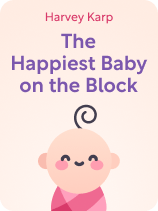

This article is an excerpt from the Shortform book guide to "The Happiest Baby on the Block" by Harvey Karp. Shortform has the world's best summaries and analyses of books you should be reading.
Like this article? Sign up for a free trial here.
How does overstimulation cause colic in babies? Can understimulation cause colic as well?
According to The Happiest Baby on the Block by Harvey Karp, the first signs you should look for if your baby has colic are overstimulation and understimulation. Karp discusses why too much or too little stimulation causes colic and techniques for soothing a baby with colic.
Keep reading to find out more.
Overstimulation and Understimulation
Karp argues that two things cause the majority of cases of colic: overstimulation and understimulation. This happens as your baby adjusts to the world outside of the womb. We’ll outline why too much or too little sensation causes colic, as well as Karp’s techniques for soothing an overstimulated or understimulated baby.
(Shortform note: While Karp mainly focuses on physical stimulation—sights, sounds, and sensations—emotional stimulation may also contribute to colic. Specifically, pediatricians believe babies may become colicky as a response to emotions like anxiety, excitement, and frustration. Some even suggest that a stressful family environment might make colic more likely, which can form a vicious cycle: The stressful environment causes colic, and the colic exacerbates the stress of caregivers in the environment.)
Why Too Much or Too Little Stimulation Causes Colic
Karp explains that newborn babies often cry incessantly because they’re unable to cope with all the new sensations around them. For the first three to four months of their lives, a baby’s nervous system is still relatively underdeveloped—Karp even refers to this period as the “missing fourth trimester,” suggesting all babies are born too early to be fully capable of handling the world outside of the womb.
(Shortform note: Anthropology research supports Karp’s conception of a “missing fourth trimester”: Researchers suggest the length of human pregnancy has much more to do with the mother’s health than with the baby’s level of development. Some argue that mothers evolved to give birth after nine months because remaining pregnant longer would require too much energy. Others suggest nine months is the “cut-off” point before a baby’s head gets too large to fit through the birth canal.)
In the womb, a fetus is exposed to consistent sensory information—steady noise levels, movement, temperature, and so on. On the other hand, the outside world can range from loud to quiet, busy to still, and cold to hot. In addition to external sensations, in the first few months, babies also experience internal sensations like digestion for the first time. Some babies are less sensitive to these changes in sensory information, don’t react as strongly to them, or are able to self-soothe and calm themselves back down. Other babies take a little longer to learn these skills: Instead, they respond to overstimulation or understimulation the only way they know how—crying a lot.
(Shortform note: Self-soothing and reactions to sensory information may seem like purely internal skills your baby has to learn on their own—their success or struggle is dependent on how quickly they can acquire these skills. However, research suggests that caregiver soothing actually helps “teach” infants how to calm themselves down. In this process, which is known as “co-regulation,” the caregiver supports the baby emotionally while modeling calm, well-regulated responses to difficult situations.)
How to Activate the Calming Response
Karp’s soothing technique simulates the comfortable sensory “middle ground” babies experience in the womb. He argues that all babies have an instinctive “calming response” when they’re exposed to these sensations. This reflex evolved because while in the womb, a calmer fetus moves less and is therefore less likely to get into the transverse or breech positions (shifting onto their side or feet-down), which can cause dangerous complications during childbirth.
Karp strongly recommends that you always soothe your crying baby. His technique for doing so consists of five different methods (what he calls the Five Ss), each of which simulates a different part of being in the womb to activate the calming response. These techniques can and should be mixed, matched, and used simultaneously—every baby will respond to them differently, so you’ll have to learn which combination works best for your baby.
1) Swaddling
Karp explains that swaddling, or wrapping a blanket around your baby, simulates the constriction of the womb. In addition to soothing your baby, swaddling helps manage their movements and reactions so it’s easier to use the other parts of Karp’s technique. Karp says you should only swaddle your baby when they’re crying or sleeping—the rest of the time, they should be unwrapped and free to explore the world.
2) Side/Stomach
The second method Karp describes is holding your baby so that they’re on their side or stomach—this is the same position babies are in while inside the womb. Note that your baby should not sleep on their side or stomach, as this increases the risk of Sudden Infant Death Syndrome, or SIDS. Karp explains baby carriers and slings can keep your baby in this position.
3) Shushing
The third method Karp discusses is shushing, or providing some kind of white noise or ambient sound. This noise, he explains, helps simulate the relatively loud environment of the womb—namely the sound of blood rushing through arteries.
4) Swinging
Karp’s fourth method is swinging, or rhythmically moving your baby. While inside the womb, fetuses are jiggled, bumped, and rocked nearly constantly whenever their mothers move. Swinging helps simulate this motion to trigger a calming response.
5) Sucking
Finally, the fifth method Karp recommends is sucking—providing your baby with a pacifier to suck on. Babies tend to suck their own fingers frequently while in the womb, and so sucking activates the calming response. It’s also pleasant because your baby associates sucking with sating their hunger. Karp explains a pacifier is preferable to finger sucking, though, because it requires less coordination and is easier to wean your baby off of (since you can easily take it away).

———End of Preview———
Like what you just read? Read the rest of the world's best book summary and analysis of Harvey Karp's "The Happiest Baby on the Block" at Shortform.
Here's what you'll find in our full The Happiest Baby on the Block summary:
- A helpful guide for parents who have babies with colic
- A theory about why babies develop colic, and how to manage it
- How to improve your baby's sleep cycles (and thus your own)






